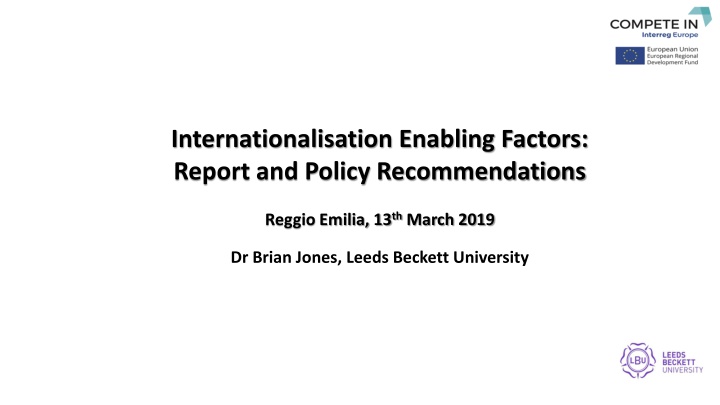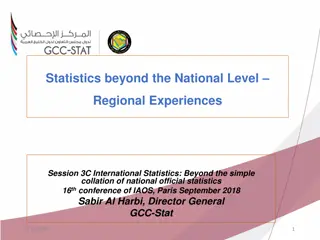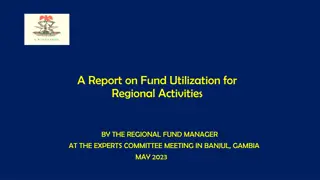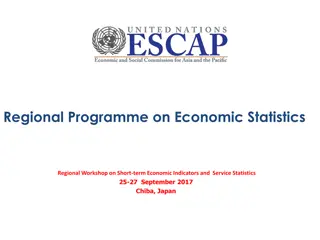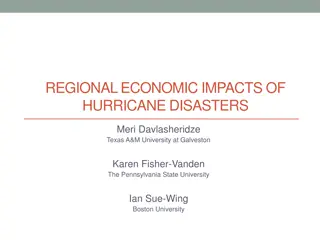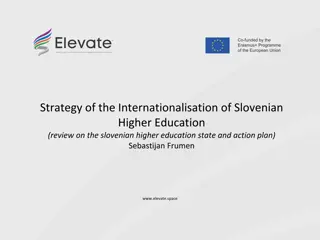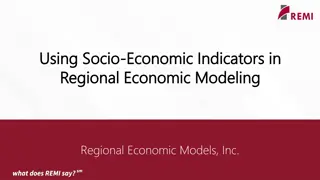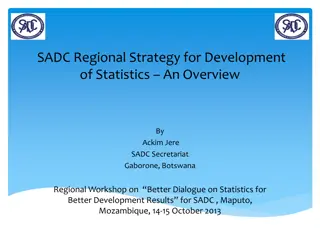Factors Influencing Internationalisation in Regional Economic Systems
The Enabling Factors Report highlights the importance of local engagement, innovation, skills enhancement, and global connectivity in promoting internationalisation within regional economies. Key themes include collaborative networking, SME support, and open cultural outlooks. Drawing from various sources, the report emphasizes the significance of economic, social, political, technological, legal, and environmental factors in driving SME internationalisation. Recommendations focus on leveraging regional strengths and fostering a conducive business environment for global expansion.
Download Presentation

Please find below an Image/Link to download the presentation.
The content on the website is provided AS IS for your information and personal use only. It may not be sold, licensed, or shared on other websites without obtaining consent from the author.If you encounter any issues during the download, it is possible that the publisher has removed the file from their server.
You are allowed to download the files provided on this website for personal or commercial use, subject to the condition that they are used lawfully. All files are the property of their respective owners.
The content on the website is provided AS IS for your information and personal use only. It may not be sold, licensed, or shared on other websites without obtaining consent from the author.
E N D
Presentation Transcript
Internationalisation Enabling Factors: Report and Policy Recommendations Reggio Emilia, 13th March 2019 Dr Brian Jones, Leeds Beckett University
Purpose of the Enabling Factors Report The output and outcome of this Enabling Factors report is to: Help project Partners to improve their approach to the internationalisation of their territory; Provide policy makers, city planners and key gatekeepers with insights on what the important levers are for internationalisation within regional economic systems; Identify ways these levers can be successfully embedded as a support for both inward investment and outward access to new markets.
Project Common Themes from Enabling Factors Report Common themes reveal the importance of local actors engagement from the public, private and non-profit sectors: The growing importance of new forms of local collaboration, networking and partnership; The central importance of innovation and of systemic support for it; The importance of enhancing technical and managerial skills and linking these to SMEs; The importance of sustaining a vibrant SME culture; The importance of an open, outward looking culture that is willing and able to develop linkages with other regions and cities across the world.
Sources: reflecting on and derived from IBPR, Altomonte et al (2014); Mariotti et al (2008), Kafouros et al (2008), and Dohse et al (2018) and also consideration of regional aspects of Saisana et al (2018). Table 1: A PESTLE of SME Internationalisation Drivers E S Economic Social Stable, open & growing regional economy education system P T L E Political Technological Good HEI & innovation system in the region Legal Environmental Accessible transport infrastructure Stable political & administrative systems Good quality regional Legal framework for foreign investment Mixed or diversified economy Stable exchangeable currency & credit arrangement Good local suppliers &/or intermediaries to work with Business support skills (legal, etc) available Mature industrial networks & sector bodies active in the region The SME s experience of other cultures & languages Resilient fast telecoms & internet Regulatory stability & openness Good quality utilities & infrastructure Support in regions for export Strong local ICT service sector & skills Good IPR protection Regional action on safeguarding standards for products Local support for new entrants Well-developed business culture & activity (e.g. chamber of commerce, regional bodies Good quality tertiary services & support ecosystem Support for regional collaboration on technology transfer & innovation Ability to work to international technical standards (e.g. CE mark, etc) Clear commercial legal frameworks & property rights Culture & commitment to sustainability Milieus of experienced mentors to support international activities Diversity of civic & cultural activity provides social capital to the region Regional powers & structures to develop initiatives & actions Regional action on connectivity, congestion & long- term planning
No single or simple answer There is a degree of devil in the detail in the measures and drivers of what makes up or can determine a region s competitive performance. Achieving or working towards best in class involves advancing across a broad front of measures and is not down to concentrating on one factor, magic bullet style.
Quality of Regions impacting Internationalisation An age where the movement of capital and labour is much freer. Overall quality of the region and locality that is a key starting point and fulcrum around which internationalisation occurs. National and regional systems of innovation are by their nature open systems where knowledge flows into and beyond the notional boundaries of the national or regional system. Smith (1997) saw two types of infrastructure as interrelated forms of collective capital: 1] hard physical infrastructure such as roads, electricity and telecommunications networks and 2] knowledge infrastructures such as universities, training systems, standards organisations, IPR protection.
Helping promote investment into/within regions: High-tech clustering (or agglomeration) around sectoral strengths; Institutional and network assets; Infrastructure and connectivity both hard (transport) and soft (knowledge- based); Soft landing and facilitation; Systems of innovation and institutional support; International linkages and openness; Regional responses to structural challenges and changes to reshape local competitivity; Quality of life and liveability strengths; and Concentrations of technological skills particularly at higher levels.
Helping drive foreign direct investment decisions: Land and premises; Support for a soft landing; Grants, financial assistance and the corporate taxation regime; Supply chain capacity; Labour skilled and semi-skilled;
Helping drive foreign direct investment decisions: Infrastructures [both hard physical assets and knowledge-based systems]; Digital infrastructure [both fibre enabled and 5G connectivity]; Research and development capacity for the inward investor to tap into; Openness, cultural, quality of life, liveability & environment, international schools; and Marketing the regional assets knowledge search & information signalling from the region to prospective investors or their agents.
Assets: The Brookings Institution s Bruce Katz and Julie Wagner in their work on innovation districts published in 2014 describe a multi-faceted Innovation Ecosystem composed of three key elements: Economic Assets, Physical Assets, and Networking Assets which sustain a synergistic relationship between people, firms and place (the physical geography of the district) that facilitates idea generation and accelerates commercialisation .
Outputs and Findings The evolution and conversion of regional economies within the EU underscores the story of the creative destruction of old sectors that has seen the restructuring of the coal and steel sectors and the re-use of space of the old industrial areas for new activities which are often cleaner, more sustainable and safer. It is also clear that regions are advancing on a broad front where the emphasis is on developing and promotion of ecosystems that includes the provision of well-appointed and high-quality space (enterprise zones, business and industrial parks, technopoles and innovation centres, etc), support for innovation activities and the development and retention of high skills.
Recommendations to Policy and Decision Makers Local and municipal authorities typically play the key leadership role in improving internationalisation. Now a much more shared process of networked governance . Local authorities are deepening existing relationships with business associations and universities. Specialised knowledge and know-how of these bodies can inform decision making and action on internationalisation. Direct overseas linkages often builds on past cultural, political, social and economic ties that shape, inform and open up opportunities.
Recommendations to Policy and Decision Makers Universities across the Compete In territories show a range of country and regional specific experience that reflect the local higher education system s past and current relationships with businesses and the wider regional economy. Universities need to ensure that they are better placed at supporting SMEs, and stimulating innovation and problem- solving activity. University staff can act as ambassadors for the regions by, for example spotting opportunities.
Recommendations to Policy and Decision Makers Business and community associations typically function as representational bodies or as specialist export agency services. Could more be done? Example through the exchange of personnel and secondments so that partners can develop detailed knowledge of the other s functioning. Potential to develop collaborative projects between a number of partners; for example, encouraging start-up or micro-SMEs to commence exporting earlier in their development.
Recommendations to Policy and Decision Makers SMEs are typically the target community for improving services and support for internationalisation around specific initiatives. Opportunity for co-opting individual leaders of specific SMEs that have special skills or know-how to contribute to internationalisation. Help to inform the development of good practices and transfer of knowledge, skills, technology etc.
Policy Recommendations for Internationalisation Local and regional authorities hoping to improve their performance on internationalisation need to focus on how they deliver services and activity in the following areas: 1] Provide a systematic and responsive service (benchmarked, monitored and performance managed) to potential investors seeking to come to the region. 2] Ensuring that there is a readily accessible, strong, modern and resilient infrastructure for the flow of people and goods into and out of the region. 3] Ensure there is a resilient and modern digital and advanced ICT infrastructure: digitalisation is a fundamental enabling technology for all sectors and economic activities. 4] Ensure that there is good access to and the mobilisation of STEM skills and particularly around ICT skills for these are the complementary assets that will guarantee that SMEs and other enterprises in the region have the absorptive capacity to develop, consume and adopt innovations as well as attract and anchor FDI. 5] Identify and support the development and promotion of supply chain linkages with FDI and between local technology-based SMEs and the local service economy. 6] Ensure that there are soft landing and facilitation spaces (such as within incubation and innovation centres) available for new entrants to the region (set-up offices, virtual offices, brokering local services & suppliers). 7] Create mechanisms for regional responses to structural challenges and sectoral changes to reshape local competitivity.
Policy Recommendations for Internationalisation Local and regional authorities hoping to improve their performance on internationalisation need to focus on how they deliver services and activity in the following areas: 8] Showcase quality of life and liveability strengths in the region. 9] Provide mentoring and support for SMEs that are looking to move into markets that are new to them, especially internationally, so that their resource base and competency is extended. 10] Facilitate and sustain the development of networks of businesses and business support organisations to share information, best practice, develop linkages and the exchange of tacit knowledge at peer-to-peer levels. 11] Enhance and develop complementary assets and ecosystems that promote added value and innovation efforts. 12] Promote high-tech clustering (or agglomeration) around existing and emerging sectoral and supply chain strengths. 13] Stimulate and support institutional engagement and network assets (e.g. trade and technical associations, executive coaching & training) to sustain a culture of learning and open innovation. 14] Promote a culture of international linkages and openness (cultural, academic, trade missions, business fairs, and mentoring SME managers to participate). 15] Identify and support innovation amongst SMEs and facilitate access to higher education and research institutions that can problem solve and act as a long-term resource for businesses.
Final remarks... Local collaboration, networking and partnership working are critical to new ways of working and problem solving. Adoption of these recommendations by different policy and decision makers is not enough in isolation, but must be integrated with the activity of others to ensure improved performance in internationalisation by a region.
THANK YOU! ANY QUESTIONS? DISCUSSION
